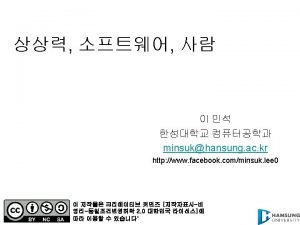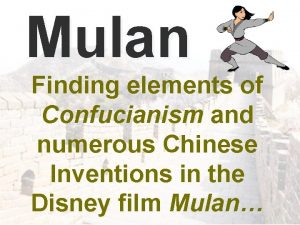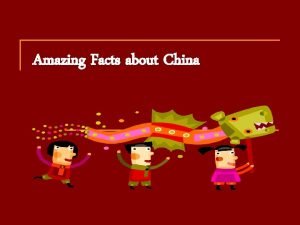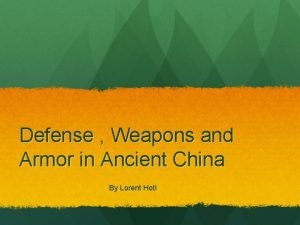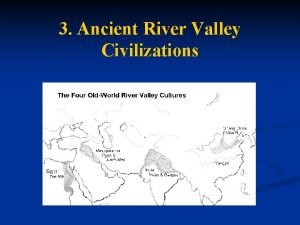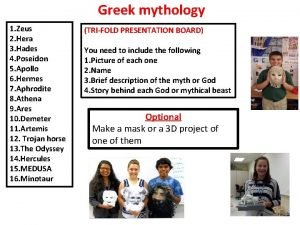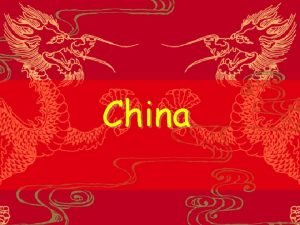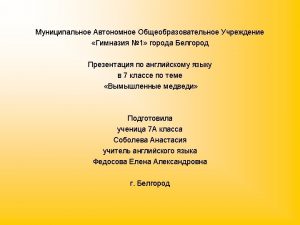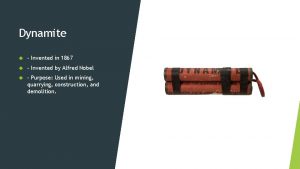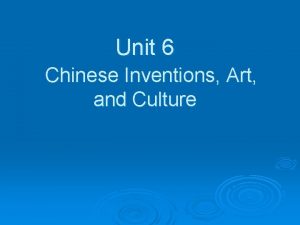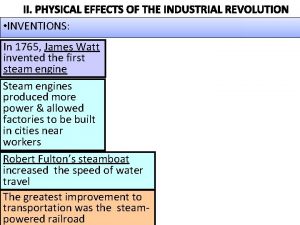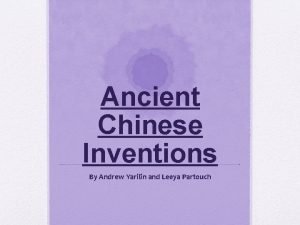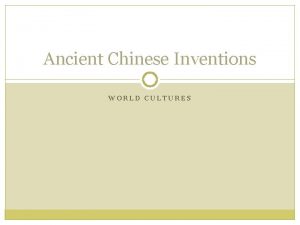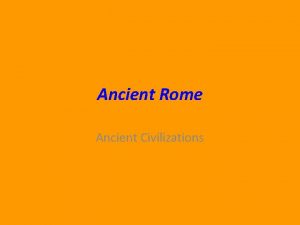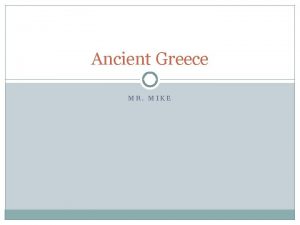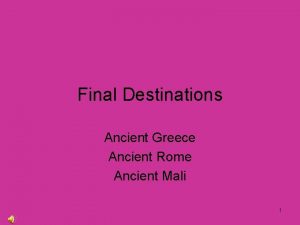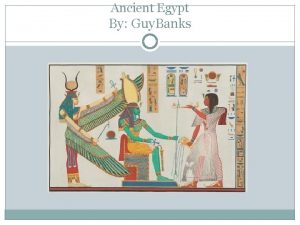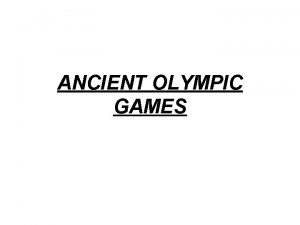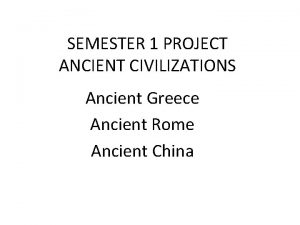Chinese Inventions Chinese Inventions The ancient Chinese invented

























- Slides: 25

Chinese Inventions

Chinese Inventions The ancient Chinese invented many things we use today, including: • paper, ink, calligraphy, printing • silk • wheelbarrows • matches, gunpowder, fireworks • the decimal system, abacus • the waterwheel • the sundial, astronomy • lacquer paint, pottery wheel, porcelain china • paper money • compass • dominoes, jump rope, kites, playing cards • folding umbrella • the crossbow • ice cream and. . . well, you get the idea. • The ancient Chinese were very inventive! We owe them a lot!

Chinese Inventions Questions Copy and answer the following questions: 1. Why do you think the ancient Chinese invented so much? 2. They invented many object used in writing such as paper, ink, and block printing. What does this tell you about the civilization? 3. Why would inventions such as porcelain, the pottery wheel, and lacquer paint have been important to the Chinese? 4. Which invention do you believe has contributed most to our modern world and why?

China’s Geography

China’s Geography The geography of ancient China can be conveniently divided up into three regions: 1)The Yangtze and Yellow Rivers; 2) The Gobi and Taklamakan Deserts; and 3) The Himalayas … The Yangtze and Yellow Rivers • The importance of the Yangtze and Yellow Rivers is hard to overstate. People mostly settled along these rivers, and different settlements were ruled by different kings. The Yangtze is banked by fertile flood plains which are added to each year when the Yangtze floods. Eventually, the Yangtze became more important economically and politically due to the establishment of irrigation systems. • Several times in the history of ancient China, the Yangtze was a political boundary between northern and southern China because it wasn’t an easy river to cross. • To the north of the Yangtze, the Yellow River is 3, 000 miles long and floods each year. Because of this, settlers in ancient China often saw their homes destroyed year after year during flood season, but eventually the people learned techniques to control flooding

China’s Geography The Gobi and Taklimakan Deserts • Most of the Gobi Desert is covered with rocks rather than sand. The Gobi Desert is located in the northwestern part of China and is one of the driest deserts in the world. It is also a very cold place in winter, with nighttime lows reaching -40 degrees Fahrenheit. Though the two are connected, geographers and ecologists regard the western part of the Gobi as a separate desert, called the Taklimakan Desert. • The Taklimakan Desert sometimes goes by the name Sea of Death. It has poisonous snakes, sand storms, and temperature extremes. It is the second largest desert in the world and is a home to species of poisonous snakes. Because of the extreme conditions of these two deserts, they acted as a protective barrier in China’s northwest.

China’s Geography The Himalayan Mountains • The people of ancient China were protected from invaders by the Himalayan Mountains, which contain several of the highest mountain peaks in the world. Because of its inland geography, the mountains not only experience extreme cold in the winter, but extreme heat in the summer, where temperatures can reach 100 degrees Fahrenheit making them a barrier not only due to their extreme heights but also their extreme weather. • Ancient Chinese history and culture were heavily influenced by its geography. With the barriers of the deserts to the northwest, and the Himalayas to the southwest, the culture remained fairly isolated for hundreds of years. The people of ancient China relied heavily on the Yangtze River and, to some extent, the Yellow River for their livelihood.

China’s Geography Questions Copy and answer the following questions: 1. Why was the Yangtze River useful to the Chinese? 2. Other than to provide water, what other role did the Yangtze River play and why? 3. Why is the Taklimakan Desert called the “Sea of Death”? 4. How did these geographical features impact movement in ancient China? 5. How does the Yangtze River represent the Theme of H-E-I?

The Great Wall & the Silk Road

The Great Wall Shih Haung-ti unified China and decided to end the Mongol threat from the north by constructing one of the largest public works projects in history. The Great Wall of China is the longest human-made structure on earth. More than a million Chinese workers connected a number of existing defensive walls into a single system fortified by watchtowers in order to keep out the Mongols.

The Silk Road Source #1: Marco Polo, The Travels of Marco Polo, a Venetian merchant who may have worked for the Yuan dynasty, the Mongol rulers of China, late 13 th century. This excerpt is a description of Hangzhou, a southern city that was part of the Yuan empire. There are within the city ten principal squares or market places, besides innumerable shops along the streets. . . On the nearer bank. . . stand large stone warehouses provided for merchants who arrive from India and other parts with their goods and effects. They are thus situated conveniently close to the market squares. In each of these, three days in every week, from forty to fifty thousand persons come to these markets and supply them with every article that could be desired. Source #2: Anonymous assistant to a Chinese merchant, A Record of Musings On the Eastern Capital, about Hangzhou, capital of the Southern Sung Dynasty, 1235. During the morning hours, markets extend from Tranquility Gate of the palace all the way to the north and south sides of the New Boulevard. Here we find pearl, jade, talismans, exotic plants and fruits, seasonal catches from the sea, wild game -- all the rarities of the world seem to be gathered here. Some of the hustlers are students who failed to achieve any literary distinction. Though able to read and write, and play musical instruments and chess, they are not highly skilled in any art. They end up being a kind of guide for young men from wealthy families, accompanying them in their pleasure-seeking activities.

The Great Wall & Silk Road Questions Copy and answer the following questions: 1. Why is the Great Wall of China significant? 2. Based on Source #1, how important were the markets of the Silk Road? What is your evidence? 3. Based on Source #2, what types of good could be purchased at the Market? 4. Based on Source #2, what can you conclude about education in Ancient China? 5. Other than the size, why would the Chinese government have committed over 1 million workers to build the Great Wall?

The Chinese Dynastic Cycle

The Chinese Dynastic Cycle From about 1766 B. C. to the Twentieth Century of the Common Era, China was ruled by dynasties. A dynasty is a ruling family that passes control from one generation to the next. One Chinese dynasty lasted more than 800 years, while another lasted only fifteen years. The ancient Chinese people often supported their rulers because of what they called the Mandate of Heaven. The ancient Chinese believed their ancestors in heaven had chosen their leaders. The people would rebel against a weak leader if they believed he had lost the Mandate of Heaven.

The Dynastic Cycle Questions Copy and answer the following questions: 1. What is the Mandate of Heaven? 2. According to the chart, what would have happened if the Old Dynasty stopped protecting its people and why? 3. According to the chart, what would have been evidence that a dynasty had lost the Mandate of Heaven? 4. What might be some benefits to families passing on control of dynasties from generation to generation? What might be some drawbacks?

Ancient China’s Government

Ancient China’s Government Despotic leadership • China was an agriculture based society with the Yangtze River as its lifeline. During the ancient period the king was the leader and acted more like a dictator than a king for the people who would make decisions beneficial to them. He had unsurpassing power in all areas, be it economy, governance, or agriculture, which was the livelihood of the people. Enlightened Leadership • Emperor Shun can be given credit for being an enlightened leader, but he was very harsh on his people. He could put any of his people to death if they did not agree with his leadership. Other punishments included using whip, stick and fines for small offences. He was succeeded by Yu, who founded Hsia, the first dynasty. • During this dynasty the Chinese government or the emperor employed huge labor to work under four groups: military, farming, construction workers and textile labor. Textile laborers were given the task of weaving silk thread by hand to make clothes for the royal family, construction work included public work such as building walls, and enlarging canals for agriculture. Military • Ancient China was most of the time caught in battles against the Huns or the invaders. In military the casualty was very high, because at that time it was quite common to have mass warfare killing thousands at the same time; ordinary soldiers were simply treated as pawns by the king and other leaders.

Ancient China’s Government Questions Copy and answer the following questions: 1. What were some characteristics of a despotic ruler in ancient China? 2. What were some punishments a leader could give to his people? 3. According to the text, what were some important jobs to the government? Why? 4. According to the text, why would military leaders often become rulers of the government as well?

Ancient Chinese Religion

Ancient Chinese Religions Taoism and Yin and Yang Religion in ancient China underwent a change around 600 B. C. A mythical figure with the name of Lao Tzu created the religious philosophy of Taoism. The ancient people of China believed in the concept of Tao, or the forces of nature. In ancient times, they believed that everything in nature had two forces that were in contrast to each other: the yin and the yang. The Yin was the female force and the Yang was the male force. The objects in nature containing yin forces were passive, cold and dark. Objects in nature that contained yang or the male force were aggressive, hot and full of light. One should use natural forces and the path of compromise to get things done favorably. Another religious belief of Taoist philosophy was that all living things had a universal force flowing through them and one should respect this force in order to have a happy life.

Ancient Chinese Religions Confucianism and Buddhism Confucius, a philosopher and a politician, was born in 551 B. C. During his early years he saw the decline of the ruling Chou Dynasty. He attributed this decline to society moving away from the traditional ways of thinking, like politeness, honor and morality. His religious philosophy reestablished these values and urged his followers to do the same. Buddhism, which has the largest following in China today, is also considered an ancient Chinese religion. It entered China along the Silk Route. The doctrine of Buddhism encourages their followers to ward off self-interest and lead a simple life without suffering through meditation and right living. Buddhists must follow the Eightfold Path in order to achieve enlightenment, or nirvana.

Ancient Chinese Religion Questions Copy and answer the following questions: 1. What does Yin and Yang represent in Taoism? 2. Why would the Yin possess passive, cold, and dark characteristics and the Yang possess aggressive, hot, and light characteristics? 3. What was the philosophy of Confucius based on and why? 4. How does Buddhism in China represent the Theme of Movement? 5. What qualities does Buddhism promote?

Homework: Confucius

Confucious Read the 3 selections from the Confucian Analects: On Confucius as a Teacher and Person 2: 4 - The Master said, “At fifteen, my heart was set upon learning; at thirty, I had become established; at forty, I was no longer perplexed; at fifty, I knew what is ordained by Heaven; 1 at sixty, I obeyed; at seventy, I could follow my heart’s desires without transgressing the line. ” 7: 15 - The Master said, “Having coarse rice to eat, water to drink, a bent arm for a pillow ‑‑ joy lies in the midst of this as well. Wealth and honor that are not rightfully gained are to me as floating clouds. ”

Confucius Questions 1. Based on the selections, who was Confucius and what was his role in Chinese society? 2. What qualities of Confucius do you think might have made him a good teacher? Do you think he would still be considered a good teacher if he were alive today in our own society? Why or why not? 3. What qualities do you think Confucius would look for in an educated person? 4. Explain the simile that Confucius uses: “Wealth and honor that are not rightfully gained are to me as floating clouds. ” 5. What is Confucius’ attitude toward life and toward himself?
 Has everything been invented
Has everything been invented Has everything been invented
Has everything been invented Buddhism in mulan
Buddhism in mulan Chinese invented ice cream
Chinese invented ice cream Means of communication in ancient times
Means of communication in ancient times Ancient india vs ancient china
Ancient india vs ancient china Ancient china weapons
Ancient china weapons Ancient chinese matches
Ancient chinese matches Ancient chinese civilization
Ancient chinese civilization Interesting facts about athena
Interesting facts about athena Ancient chinese religion
Ancient chinese religion Primary 3 malay worksheets
Primary 3 malay worksheets Quá trình desamine hóa có thể tạo ra
Quá trình desamine hóa có thể tạo ra Vẽ hình chiếu vuông góc của vật thể sau
Vẽ hình chiếu vuông góc của vật thể sau Thế nào là mạng điện lắp đặt kiểu nổi
Thế nào là mạng điện lắp đặt kiểu nổi Công của trọng lực
Công của trọng lực Lời thề hippocrates
Lời thề hippocrates Tỉ lệ cơ thể trẻ em
Tỉ lệ cơ thể trẻ em Các loại đột biến cấu trúc nhiễm sắc thể
Các loại đột biến cấu trúc nhiễm sắc thể Bổ thể
Bổ thể Vẽ hình chiếu đứng bằng cạnh của vật thể
Vẽ hình chiếu đứng bằng cạnh của vật thể Sự nuôi và dạy con của hổ
Sự nuôi và dạy con của hổ độ dài liên kết
độ dài liên kết Các môn thể thao bắt đầu bằng tiếng nhảy
Các môn thể thao bắt đầu bằng tiếng nhảy điện thế nghỉ
điện thế nghỉ Thế nào là sự mỏi cơ
Thế nào là sự mỏi cơ

